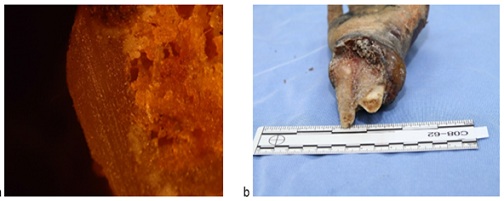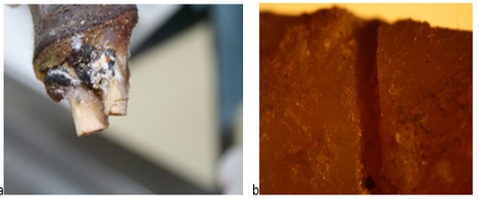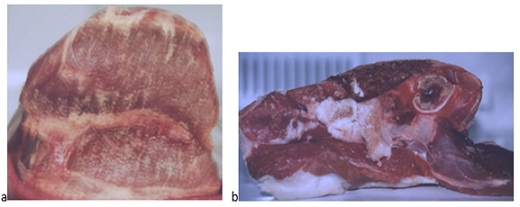
Determining Saw Type from the Surface of Severed Flesh: Potential for Use in Homicidal Dismemberment Investigations
*Corresponding Author(s):
Conrad B QuintynDepartment Of Anthropology, Criminal Justice, And Sociology, Commonwealth University--Bloomsburg, Bloomsburg, Pennsylvania, United States
Email:cquintyn@commonwealthu.edu
Abstract
Flesh and bone dismemberment using a saw created more recognizable patterns than using a single-edged, non-serrated knife. In a 2008 Pennsylvania state murder case, smooth, clean cuts in the soft tissue indicated that a mechanical saw as opposed to a manual saw was used to dismember the victim. To explore further this type of dismemberment and to improve identification and accuracy for future cases, a simple experiment was conducted to learn how soft tissue responds when cut with a hand-held as opposed to a mechanical saw, at both warm and cold temperatures. A killer might find it convenient to store a body in a freezer temporarily to prevent discovery, and then subsequently dismember the semi-frozen body. A 5-pound lamb hind limb and a 3.2-pound pork shoulder butt roast were used to simulate human flesh. The meats were cut initially while frozen (15° F/-9° C.), and then cut when thawed (50° F/10° C). When cutting frozen meat, the mechanical and reciprocating hand-powered saws left a neat, smooth sliced surface. Cutting the unfrozen meat, the mechanical and reciprocating hand-powered saws left some tearing of the muscle fibers and tendons on the sliced surface. This study shows that it is possible to identify a class of tool by analyzing the surface of flesh severed in different environmental conditions.
Keywords
Bone; Dismemberment; Flesh; Saw marks; Tool mark analysis
Introduction
On January 29, 2008, Pennsylvania State Department of Transportation workers found various severed body parts in eight trash bags scattered along the Interstate 80/380 corridor through Monroe County and into Lackawanna County. What type of weapon or tool did the killer use to decapitate the victim, cut off her hands, and sever her remaining limbs? The answer to this fundamental question might narrow the focus of the investigation, saving time as police search for a killer.
Based on the cut marks in soft tissue and the characteristics of the severed limbs, the biological anthropologist determined that the killer used a single-edged, non-serrated knife and a hacksaw to dismember the victim.
Forensic Anthropology And Tool Mark Analysis
Forensic anthropology is defined as applying the techniques of human osteology to legal investigations. biological anthropologist study the human skeleton in an attempt to determine race, sex, age, stature, physique, trauma, and manner of death. Occasionally, they are asked to assess projectile trauma, blunt force trauma, and sharp force trauma on bone and soft tissue in order to identify the weapon used to inflict damage. Tool ‘diagnostic’ marks found on a victim’s remains potentially could be damaging to the defense attorney, especially if her client stands accused of homicidal dismemberment. Tool diagnostic marks have been found in bullets, boot prints, tire tracks, and saw marks in severed bone (although no published standards exist for knife and saw mark analysis) [1].
Knife and saw mark analysis in bone has shown that all blades leave diagnostic clues as they cut, regardless of the extent of the blades’ wear [2]. While this research has been successful in identifying a ‘class’ of tool, it has thus far been unsuccessful in identifying a specific weapon. Nonetheless, identifying a class of tool leads the investigator one step closer to the killer. Identification will be successful, though, only if crime scene investigators consult biological anthropologist immediately after dismembered human remains are found, so that the anthropologists can direct the photographing of the wounds. For instance, thorough photography (and video) should document the anatomical distribution of wounds, and record in close-up view the details at each dismemberment site [3]. If this attention to detail results in the identification of the class of tool used in the dismemberment, it can provide powerful ammunition for the prosecution in securing a conviction.
The class of tool used for cutting the flesh in the dismemberment of the Pennsylvania victim mentioned above produced no recognizable patterns; consequently, the tool could only have been a single-edged, non-serrated knife. However, the flesh and bone dismemberment using a saw created more recognizable patterns. In bone, for example, when amplified by a microscope, key characteristics appeared. Visible parallel striations (tiny marks across the bone surface) left by the saw blade were apparent (Figures 1a&1b). Additionally, one will find an incomplete cut in the bone called a false start kerf (Figures 2a&2b).
 Figure 1a-b: a) Parallel striations seen on the surface of the severed radial bone. Image taken by a Leica LED stereomicroscope [40X]; b) preserved left hand of the victim severed at the distal ulna and radius.
Figure 1a-b: a) Parallel striations seen on the surface of the severed radial bone. Image taken by a Leica LED stereomicroscope [40X]; b) preserved left hand of the victim severed at the distal ulna and radius.
When magnified, we see a distinctive rectangular cross section kerf floor indicative of a saw mark (as opposed to a knife mark] (Figures 2a&2b).
 Figure 2a-b: a) Severed radial bone (smaller bone, right) shows the ‘nick’ in the bone or false start kerf; b) Rectangular cross section of kerf floor. Image taken by a Leica LED stereomicroscope [40X].
Figure 2a-b: a) Severed radial bone (smaller bone, right) shows the ‘nick’ in the bone or false start kerf; b) Rectangular cross section of kerf floor. Image taken by a Leica LED stereomicroscope [40X].
Furthermore, smooth, clean cuts in the soft tissue indicated that a mechanical saw and not a manual one had been used. Three weeks after the body was found, Pennsylvania State Police searched a suspect’s house based on information provided by a private citizen and found both a hacksaw and a mechanical saw, in addition to the victim’s dismembered hands (Figures 3a-3c). In essence, the biological anthropologist’s suspicions about the tools were correct.
 Figure 3a-c: a) Preserved victims hands discovered in suspect’s apartment; b-c) Different types of saws discovered in suspect’s apartment.
Figure 3a-c: a) Preserved victims hands discovered in suspect’s apartment; b-c) Different types of saws discovered in suspect’s apartment.
To explore further this type of dismemberment and to improve identification and accuracy for future cases, a simple experiment was conducted to discover how soft tissue responds when cut with a hand-held as opposed to a mechanical saw, at both warm and cold temperatures. A killer might find it convenient to store a body in a freezer temporarily to eliminate the odors of decomposition and thus reduce the probability of detection, and then subsequently dismember the semi-frozen body.
Materials And Methods
The biological anthropologist used a 5-pound lamb hind limb and a 3.2-pound pork shoulder butt roast to simulate human flesh (the fact that two types of meat were used was a coincidence that proved insignificant to the outcomes.) The meats were cut initially while frozen (15° F/-9° C.) Subsequently, they were allowed to thaw, and then cut at 50° F/10° C. Two different saw types were used to cut the meats (Table 1).
|
Hand-powered backsaw characteristics |
Mechanical or meat saw characteristics |
|
•tooth width: 0.030 inch •teeth per inch: 11 •points per inch: 12 •tooth type: chisel •blade length: 12 inches •cut direction: reciprocating
|
•tooth width: 0.020 inch •teeth per inch: 4 •points per inch: 5 •tooth type: chisel •blade length: 16.5 inches •cut direction: continuous
|
Table 1: Two different saw types were used to cut the meats in this experiment.
Results And Discussion
(Table 2) details the different reactions of soft tissue to cuts with a mechanical saw and a hand-powered saw. Visually, the image in (Figures 4a&4b) shows the neat, smooth surface of the sliced frozen meat that was cut using a mechanical saw and the same frozen meat cut with a reciprocating hand-powered saw in (Figures 4a&4b). The smooth cut surface is obvious, but there is localized smudging of muscle tissue due to the tearing action of the saw points.
|
Temperature 0F Meat* |
Hand-powered backsaw |
Mechanical or meat saw |
|
15 |
Neat, smooth cut |
Neat, smooth cut w/ localized smudging of muscle tissue |
|
50 |
Moderately smooth cut w/ generalized smearing of muscle tissue |
Untidy cut, muscle tissue torn apart |
*Pork shoulder and lamb hind limb
Table 2: General characteristics of surface of sliced meat in warm and cold environments using hand-powered and mechanical saws.
 Figure 4a-b: a) Smooth, clean surface of meat cut using mechanical saw at 150 F; b) smooth, surface of meat with localized smudging cut with hand-powered saw at 150 F.
Figure 4a-b: a) Smooth, clean surface of meat cut using mechanical saw at 150 F; b) smooth, surface of meat with localized smudging cut with hand-powered saw at 150 F.
In Figures 5a&5b, unfrozen meat cut with the mechanical saw shows the moderately smooth surface of the sliced meat with generalized smearing of the muscle fibers and tendons. In contrast, (Figures 5a&5b) shows the rough surface of the unfrozen meat with muscle tissue torn apart by the reciprocating action of the hand-powered saw.
 Figure 5a-b: a) Surface of meat smooth with generalized smearing of muscle fibers and tendons cut with mechanical saw at 500 F; b) surface of meat torn apart cut with hand-powered saw at 500 F.
Figure 5a-b: a) Surface of meat smooth with generalized smearing of muscle fibers and tendons cut with mechanical saw at 500 F; b) surface of meat torn apart cut with hand-powered saw at 500 F.
This basic study shows that it is possible to identify a class of tool by studying the surface of flesh severed in different environmental conditions. In this instance, the damage to flesh produced by a mechanically powered saw is distinguishable from damage produced by a hand-powered saw.
What if a knife was used to slice frozen and room-temperature meat? The sawing or reciprocal action of the knife would create patterns similar to those evident when a hand-powered saw is used. However, knives are rarely used to accomplish dismemberments. Studies of the shallow cuts on the long bones of mutilated victims suggest frustrated attempts by the killer to cut into bone using a knife [3].
Conclusion
As the number of criminal dismemberments increases, there will be a greater need for the evidence concerning probable tools used in crimes where examining soft tissue and bone cuts can be useful [3]. While the analysis of the soft tissue will not identify a specific weapon/tool or link weapon to killer, it will certainly narrow the focus of the investigation.
Careful documentation of the evidence, particularly the cut marks in this instance, must be paramount in the investigators’ work. In addition, all available severed bone and soft tissue must be collected and studied before the remains are disposed of. Dismembered bodies are usually cremated and there will be no opportunity to recover additional evidence. Thorough analysis of evidence will be critical in reconstructing the killer’s intent and behavioral preferences, in order to corroborate or contradict eyewitness accounts and to exclude or include suspects.
Conflicts of Interest
None
Acknowledgements
None
References
- Symes SA, Williams JA, Murray EA, Hoffman JM, Holland TD, et al. (2002) Taphonomic context of sharp-force trauma in suspected cases of human mutilation and dismemberment. In William Haglund and Marcella Sorg (eds.). Advances in Forensic Taphonomy: Method, Theory, and Archaeological Perspectives. Boca Raton: CRC Press 403-434.
- Daubert V (1993) Merrell Dow Pharmaceuticals, Inc., 509 U.S. 579.
- Reichs KJ (1998) Postmortem dismemberment: Recovery, analysis and interpretation. In Kathleen Reichs (ed.). Forensic Osteology: Advances in the Identification of Human Remains. Second Edition. Springfield: Charles C. Thomas Publishers 353-388.
Citation: Quintyn CB (2024) Determining Saw Type from the Surface of Severed Flesh: Potential for Use in Homicidal Dismemberment Investigations. Forensic Leg Investig Sci 10: 100.
Copyright: © 2024 Conrad B Quintyn, et al. This is an open-access article distributed under the terms of the Creative Commons Attribution License, which permits unrestricted use, distribution, and reproduction in any medium, provided the original author and source are credited.

